Interview with Jason Bruges, Master of Interactive Art and Design
In this exclusive interview for Design Insider, we delve into the illuminating work of Jason Bruges, the Founder and Creative Director of Jason Bruges Studio. Renowned for his pioneering work in interactive spaces that merge architecture, art, and technology, Jason offers insights into his creative journey, the role of AI and real-time data in his artworks, and the profound impact his installations have on office environments.
Discover how Jason Bruges Studio crafts ‘living and breathing’ artworks that transform mundane office settings into dynamic, engaging spaces, fostering creativity and well-being among its inhabitants.
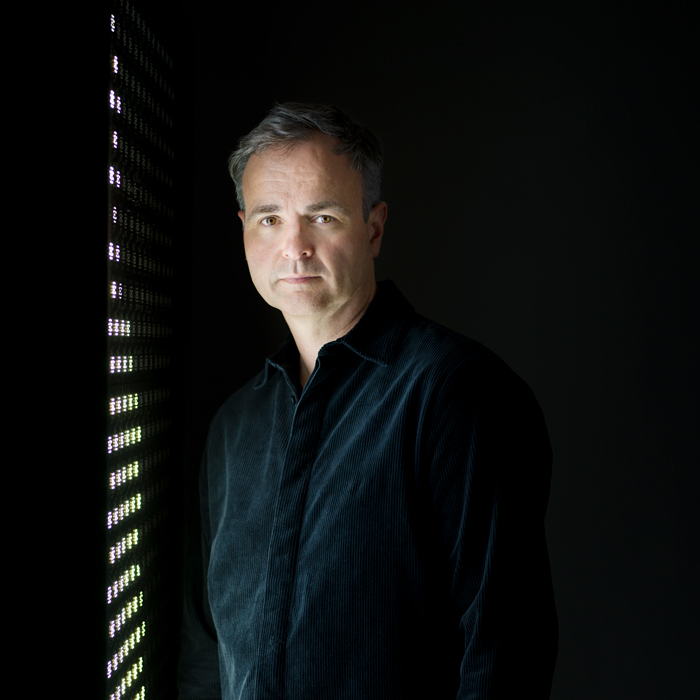
Jason Bruges, Founder and Creative Director of Jason Bruges Studio
Could you introduce yourself, your role, and give us a brief overview of Jason Bruges Studio? What drives your passion for creating interactive spaces and surfaces that blend architecture, installation art, and interaction design?
I founded Jason Bruges Studio in 2002. As Creative Director I lead the vision and philosophy of our work which is born out of my post-graduate research. I studied at the Bartlett, UCL, where I was heavily influenced by Peter Cook and his performative approach to architecture. During this time, I felt dissatisfied with the static nature of the built environment and saw potential for interventions that add animation and bring urban spaces to life. Shortly after graduating, I began entering public art competitions and when I won one, it basically forced me to set up the Studio in order to actually deliver the work. Today, I lead a multidisciplinary team of 25 to deliver dynamic, spatial art installations around the world.
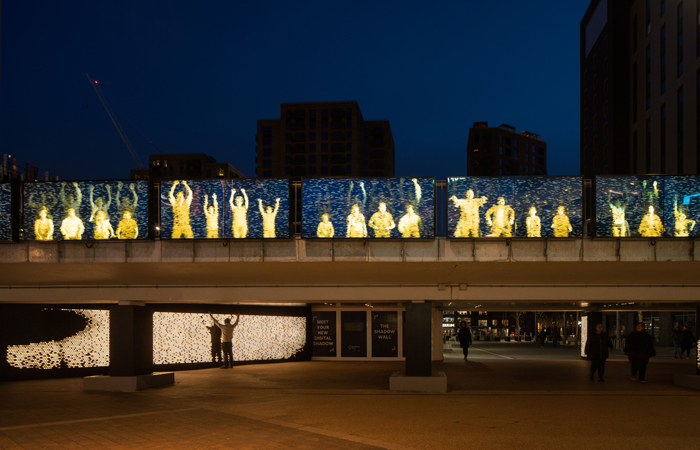
Shadow Wall 2019. Image: James Medcraft
What inspired you to start using AI and real-time data in your artworks, and how do you believe this technology enhances the relationship between art and its viewers, especially in office environments?
There’s an ordered chaos found in nature that’s hard to recreate without computer algorithms – the to and fro of ocean waves, the way a tree naturally branches or the lick of flames in a fire. These naturally occurring, generative, emergent rhythms have always fascinated me. There’s something inherently calming about them that can offer moments of respite and relaxation in office environments. Using AI and real-time data also introduces an element of unpredictability which imbues an artwork with a sense of renewal. This contributes to more lively refreshing office environments and breaks up what might otherwise be a routine day in the office.
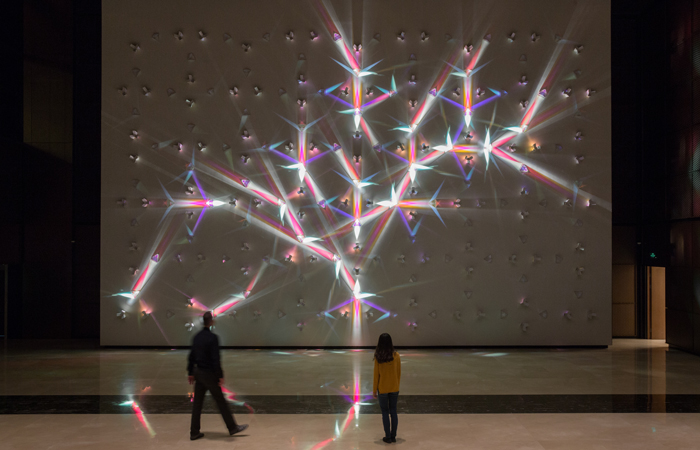
Dichroic Blossom 2014: Image: James Medcraft
Could you walk us through your creative process in conceptualizing and designing ‘living and breathing’ artworks? How do you decide which aspects of an office environment to reflect or enhance through your installations?
Every project begins with a thorough analysis of the site and in-depth conversations with our clients. This unearths multiple routes which we start exploring through sketches, animations and physical maquettes. Ideas might be derived from the data our client’s work with, the brand personality, qualities of the natural environment in which the company is situated or how staff are occupying the space. Always highly tailored. We also consider what functions the artwork might need to fulfil beyond simply decoration whether that be storytelling, brand experience or facilitating collaboration. Once we have chosen one route forward, we very quickly start prototyping in our workshop and always make a 1:1 scale mock-up of an artwork before any final fabrication is undertaken.
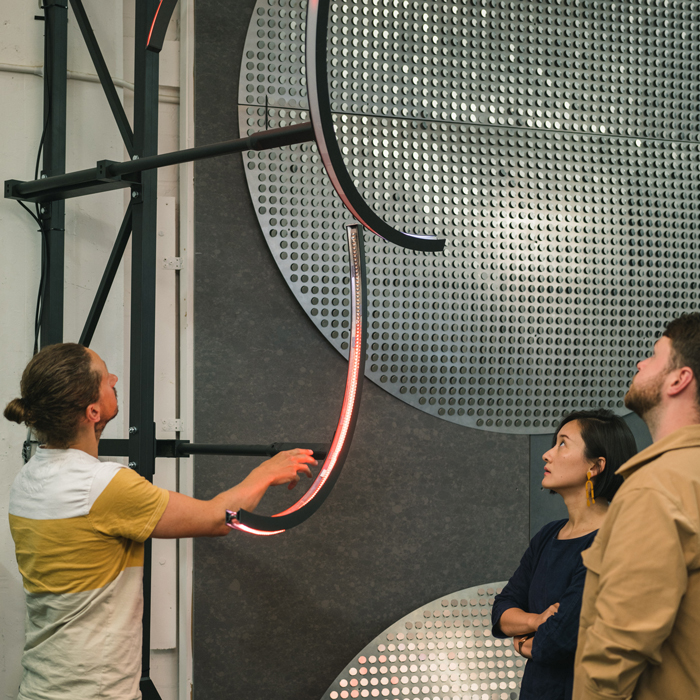
Prototyping. Image: Netil House, Emily Marshall
Integrating AI and real-time data into art requires a blend of creativity and technical expertise. Can you discuss some of the technical challenges you face in creating these dynamic installations and how you overcome them?
I think you’re right that it’s the blend of creative and technical skills that’s most important. The data alone isn’t enticing it’s our artistic interpretation of it which makes it interesting. One of the biggest challenges is ensuring the design of the content (the choreography of the light and movement) and canvas (the physical display system) happens in an integrated way. The two must work together harmoniously. Another challenge is that we can’t control how the data will evolve over time. Therefore we have to introduce parameters that ensure the artwork remains aesthetically appealing and engaging. Another challenge can be accessing the data from a client, deciding what data is in fact useful and what format it should be in.
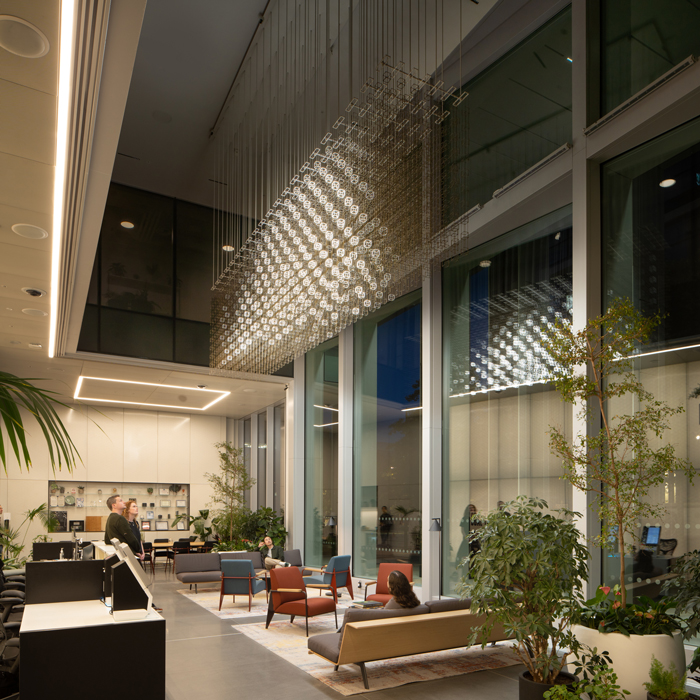
Lux Automata 2022: Image: JamesMedcraft
How do your installations engage with and respond to the presence and behaviour of people within office spaces? Can you provide an example of how real-time data has been used to create a unique, interactive experience?
We’re often creating layered experiences that respond to multiple inputs. This makes for ever-evolving outcomes that inject a sense of liveliness into the office. Recently, we had the opportunity to create a monumental art installation for Hankook Tire’s Technoplex in Seoul. We were invited to respond to the arrival experience, where staff and visitors travel up through a vast central oculus space. Our idea was to create a huge tree-like media canopy. Using an open weather API, the metaphorical leaves change colour with the seasons and digitally rustle as people pass by so entering the building feels like walking through a forest.
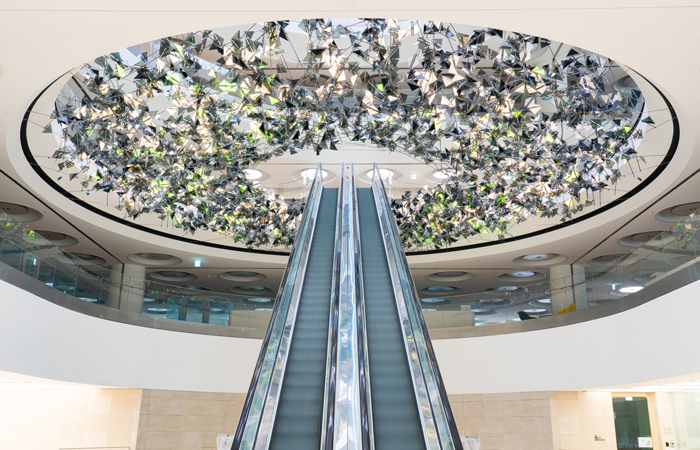
Digital Phyllotaxy 2020. Image: Giraffe Pictures
In your view, how do ‘living and breathing’ artworks influence the atmosphere and dynamics of office environments? Have you observed any notable effects on creativity, productivity, or well-being in workplaces featuring your installations?
As the battle between home and office continues post Covid, we’re definitely seeing employers look to art as a way of luring people back in. Many of the positive impacts were documented in Brookfield Properties The Art of Workplace Report in 2022 which notably found 69% of its respondents agree that art in the workplace contributes to wellbeing. One of our app developer clients, Brainium, has reported how Reaction Diffusion (2022) gamifies their employee’s activity. By turning problems such as bugs and app crashes into a physical performance it cultivates collaboration. For our AI client, DeepMind, Lux Automata (2022) represents the first time its software has been given a physical form and they have described how this facilitates dialogue and experimentation.
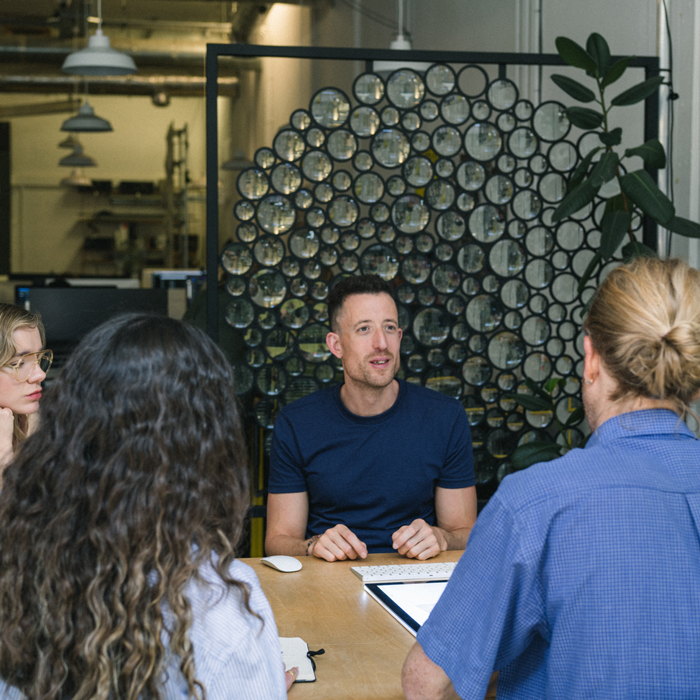
Team. Image: Netil House, Emily Marshall
Creating complex, interactive art installations must require a diverse skill set. Can you talk about the collaborative process within your team and with clients when developing a project? How do you ensure that the final artwork aligns with the client’s vision and the space’s requirements?
Internally our approach is inherently multidisciplinary – we employ architects, software developers, engineers and visualisers who constantly exchange ideas. From a project kick off we assign a design and production lead, so feasibility is always considered as concepts are being developed. It’s always really important for us to spend time with our clients in their office space and we invite them to experience our studio. That way we understand each other’s way of thinking which facilitates the best relationship and ultimately creative outcome. We also deliberately follow a very iterative, open process so ideas can always be shaped in response to feedback and use tools such as AR and VR to visualise how artworks will eventually look in the space.
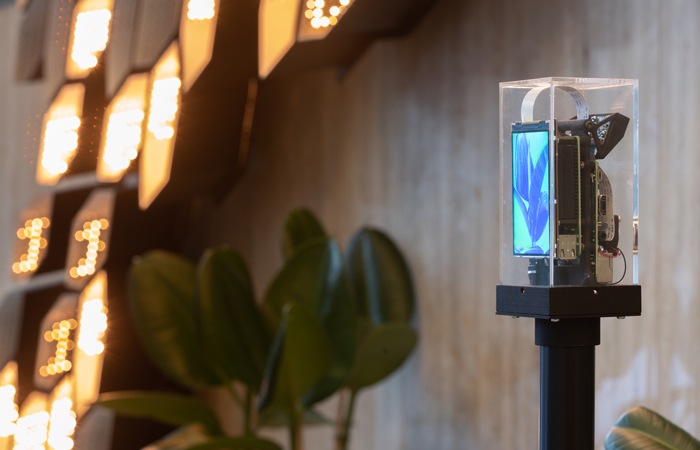
Variegation Index 2019. Image: James Medcraft
Looking forward, how do you see the role of AI and real-time data evolving in the field of art and design, particularly in creating interactive environments? Are there any emerging technologies or trends you are excited to explore in your future projects?
I’m not particularly driven by trends. A lot of the Studio’s work actually uses quite old technologies but applies them in unique ways. I think this crafted, bespoke approach adds to their timelessness. I’d like to see AI used to create more responsive environments that adapt to the needs of their individual users but in more creative ways than we’re seeing now. I think the post-covid environment will continue to push employers to create evermore enticing and imaginative workspaces and think the role for media art within that will continue to grow as its value is more deeply understood. I’m particularly interested in how technology will evolve to mimic natural systems and this is something we’ll continue to explore in our projects. We’re also keen to push our experiments that blends technology with natural materials like plants and water.




